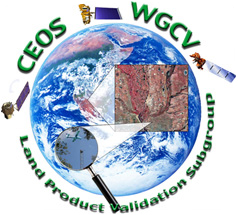
Focus Area on Land Surface Temperature & Emissivity Product Validation
Lluís Pérez-Planells, Mediterranean Center for Environmental Studies (CEAM), Spain
Thomas Holmes, NASA Goddard Space Flight Center, USA
Land Surface Temperature Definition
Land surface temperature (LST) is a kinetic quantity, independent of wavelength, that represents the thermodynamic temperature of the skin layer of a given surface, i.e. it is a measure of how hot or cold the surface of the Earth would feel to the touch. For ground-based, airborne, and space borne remote sensing instruments LST is the aggregated radiometric surface temperature based on a measure of radiance. Therefore, in the literature, LST is also referred to as (directional) radiometric temperature or skin temperature. When derived from radiometric measurements of remote sensing instruments, LST represents the aggregated radiometric surface temperature of the ensemble of components within the sensor's field of view (Norman and Becker, 1995). This definition has been adopted by various international groups, e.g. CEOS WGCV, GCOS, ESA GlobTemperature, and ILSTE-WG.
Units: The unit of LST is Kelvin [K]. Degree Celsius [°C] is also commonly used.
Norman, G., and Becker, F. (1995). Terminology in thermal infrared remote sensing of natural surfaces. Agricultural and Forest Meteorology, Volume: 77, Issue: 3-4, Pages: 153-166,
DOI: 10.1016/0168-1923(95)02259-Z
Land Surface Emissivity Definition
Emissivity a wavelength-dependent quantity defined as the ratio of the radiance actually emitted by an isothermal,homogeneous body and the radiance emitted by a black body at the same thermodynamic temperature (Norman and Becker 1995).
Units: Dimensionless.
Highest Validation Stage Currently Reached for Satellite-Derived Land Surface Temperature and Emissivity Products
Validation stage 3 (LPV validation stage hierarchy) - The highest LPV validation stage reached for satellite-derived land surface temperature and emissivity products. While the number of in situ validation stations is indeed limited, 'radiance based-validation' extends available sites considerably. Radiance-based validation uses static in-situ emissivities, e.g. determined from field samples in the lab or simply well known (as for dense vegetation or water) sites. This extends the number of sites sufficiently to be considered globally representative
Validation Good Practices
The purpose of validation is to characterize product uncertainties and to evaluate the performance of retrieval algorithms. Four categories of validation methods (Schneider et al., 2012) are commonly used to assess a satellite LST product's compliance with its specifications:
- Ground-based validation refers to comparisons with LST obtained from in-situ measurements: if the measurements are performed with well maintained, high quality instrumentation and are representative for the satellite sensor footprint, it represents the reference validation method.
- Radiance-based Validation is a comparison against the surface temperature that minimises the difference between the radiance measured by the satellite and that obtained with a radiative transfer model. The method requires accurate surface emissivities as well as atmospheric temperature and water vapour profiles coincident with the satellite overpass.
- Satellite Product Inter-Comparison with another - generally already validated - LST product. The method is particularly valuable for identifying disagreements between LST products over large areas and different land cover types.
- Time Series Inter-Comparison is used to detect instrument problems, e.g. calibration drift, or outliers due to undetected clouds. The approach requires a relatively long time series of observations over temporally stable targets, e.g. inland water bodies or deserts.
The above categories complement each other and provide different information about the quality of an LST product. Due to a lack of global reference datasets, methods from all four categories are required to achieve Stage-3 validation status. Over homogeneous sites state-of-the-art satellite LST and ground-based LST are generally expected to agree with each to within 1-2 K.
Current methods and best practises for land surface temperature and emissivity product validation are described in the following documents:
Guillevic, P., Göttsche, F., Nickeson, J., Hulley, G., Ghent, D., Yu, Y., Trigo, I., Hook, S., Sobrino, J.A., Remedios, J., Román, M. & Camacho, F. (2018). Land Surface Temperature Product Validation Best Practice Protocol. Version 1.0. In P. Guillevic, F. Göttsche, J. Nickeson & M. Román (Eds.), Good Practices for Satellite-Derived Land Product Validation (p. 58): Land Product Validation Subgroup (WGCV/CEOS), doi:10.5067/doc/ceoswgcv/lpv/lst.001
Göttsche, F., Olesen, F.S., Høyer, J.L., Wimmer, W., and Nightingale, T. (2017). Fiducial Reference Measurements for Validation of Surface Temperature from Satellites (FRM4STS).Technical Report 3 - A Framework to Verify the Field Performance of TIR FRM. Internal Publication, OFE- D120-V1-Iss-3-Ver-1-ISSUED, Issue 3 Revision 0, page 1-75.
Schneider, P., Ghent, D., Corlett, G., Prata, F., and Remedios, J., 2012. AATSR validation: LST validation protocol. Internal publication, UL-NILU-ESA-LST-LVP Issue 1 Revision 0, page 1-39.
Land Surface Temperature and Emissivity Validation Reference Data Sets
Currently available reference data for satellite-derived LST and emissivity validation are often campaign-based. For a few sites longer time series are available:
- The JPL network: Calval, Lake Tahoe, Salton Sea, Russell Ranch, Emissivity
- The Surface Radiation (SURFRAD) network
- Karlsruhe Institute of Technology (KIT) stations
- The stations of the Copernicus LAW project
- The Global Change Unit (GCU)
- The ASTER Spectral Library
A more complete and detailed list of current in-situ LST validation sites is provided here.
- NASA Official: Sadashiva Devadiga
- Website Manager: Jaime Nickeson
- Last Updated: October 8, 2025


